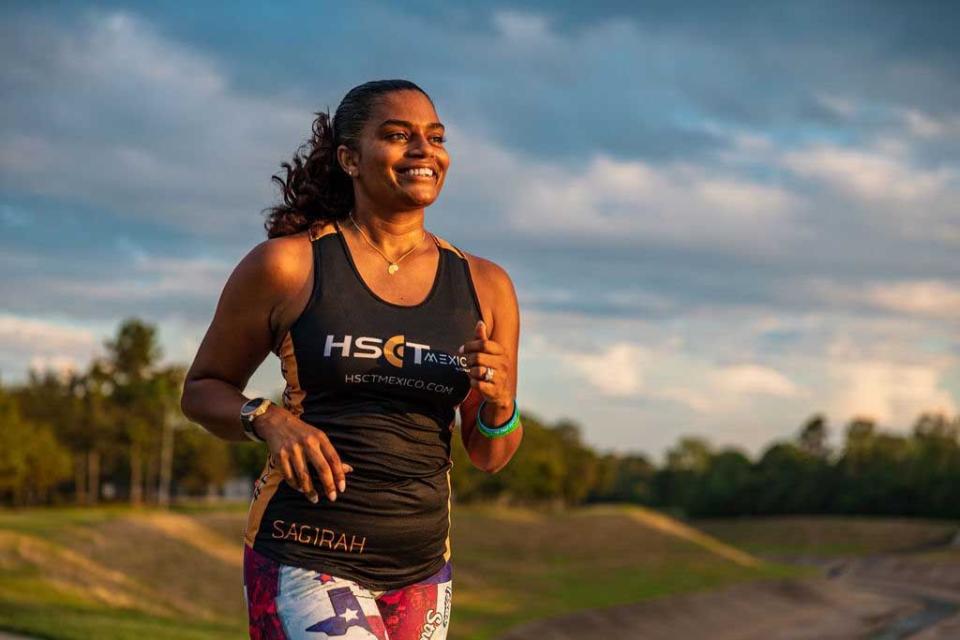I‘m a Runner, and My MS Has Made Me More Determined Than Ever

I started training for my first marathon in 2016. I’m competitive by nature, so I had high expectations of myself and was excited to show off my skills to my family in my hometown of Chicago. But things didn’t go as I’d planned. During the race, I had trouble lifting my foot. I stopped for a while in the medical tent and ended up walking, rather than running, to the finish line. It wasn’t the way I’d hoped to finish but I figured that a visit to a doctor in Houston, where I live, would get me through my injury.
This story is part of Prevention’s We Are Not Invisible project, a series of personal and informative stories that shed light on those with Invisible Disabilities in honor of Invisible Disabilities Week 2022.
By the time I went to the doctor, though, I was noticing other symptoms that caught me off guard. For instance, not only was I having trouble lifting my foot (known as foot drop), I was feeling exhausted daily and often I wasn’t able to feel my extremities. The doctor told me I didn’t have a sports injury and that instead I should see a neurologist. After several frustrating months of appointments and testing—including an MRI and bloodwork— I was diagnosed with primary progressive multiple sclerosis, which is a disease that develops when the immune system attacks the central nervous system and causes nerve damage. The “progressive” part of my diagnosis meant that my symptoms would continue to get worse and would drastically limit my functioning. Oddly enough, getting the diagnosis was a bit of a relief because I finally knew the reason I was experiencing tremors, numbness, and fatigue. Of course, I was also scared, but I was referred to an MS clinic near me and I trusted that the doctors there would help me.
Living life with MS
To my shock, I was told that based on my neurological loss, I would have only about five more years until I’d be confined to a wheelchair. They told me to travel and do all the things I wanted to do while I was still able. Not wanting to think about the future, my husband Joe and I chose to focus on the present and travel to as many places on our bucket list as possible, as quickly as we could.
In April of 2019, we took our first bucket-list trip to Ireland. As luck would have it, there was an MS run/walk happening there and we signed up. In the race packet, I read about “HSCT” (technically called hematopoietic stem cell transplantation) for the first time, which was described as an experimental treatment that could stop MS progression by essentially wiping out your immune system then receiving healthy stem cells to “reset” it. There are trials underway here, but it’s not available in the U.S. as a standard treatment option—and it’s extremely expensive, risky, and new. So I put it on the back burner and continued to focus on making the moments I had count.
I continued running, but it was getting harder and harder. Even though I didn’t want to acknowledge it, I had to come to terms with the fact that my racing days were limited. I remember telling my running partner that once it became impossible for me to run, I’d just cheer her on. But I was hard headed and wasn’t going to stop without a fight.
What my invisible disability looks like
I usually didn’t even appear to have a disability to the outside world. In fact, when I was first diagnosed and got the handicap placard for my car, people actually yelled at me for using a handicap space because they didn’t think I had a true disability. That would upset me, but I’m not one to yell out my personal diagnosis across a parking lot to someone who is unimportant to my life, so I tried to ignore that as much as I could. One thing that helped, however, was that I got a therapy dog, named Hope, who was trained through the National Multiple Sclerosis Society to recognize and assist with tremors and seizures. I put a vest on her that said, “I’m visible. Her disability isn’t.”
As Joe and I were about to fly to Paris on our second bucket-list trip—where I was planning to run my last half marathon ever—I came to a realization. There I was in the airport, using a cane (albeit a cute one), wearing an e-brace on my leg (a device that sends electrical shocks to help me lift my foot), and watching Joe lug around a big wheelchair the doctors had suggested we bring just in case I needed it. And it struck me that if I didn’t try to stop the progression of my MS, we were headed for a lifetime with that wheelchair and a future where my husband and daughter would have to wait on me hand and foot.
So Joe and I decided we had to at least see if I was a candidate for HSCT. The treatment is not for everyone with MS, but I qualified for it, and we hurried to make arrangements to go the HSCT clinic in Mexico in January 2020. I had a lot of fears and there was a 20 to 30 percent chance that the treatment wouldn’t work, but I felt that this was my shot, and I had to take it.

Where I am today
The treatment wasn’t easy, but I really did go into the clinic with my cane, and walked out of the clinic a month later on my own. It was surreal. Afterwards, my physical therapist helped me to strengthen the muscles I’d stopped using and retrain my weakened body, and slowly but surely, I learned to walk and run with an improved gait that helps me control my foot. I wasn’t the same runner I was before my MS diagnosis but I was determined to run marathons again because training puts me in a positive mindset and gives me something to work toward.
I soon learned that I qualified for the 2021 Boston Marathon as an adaptive athlete (a person with disabilities who is allowed modifications during sports competitions) and I went for it. Unfortunately, during the race, I had to stop at mile 20 because I suffered an extreme bout of foot drop. I had to move forward carefully so as not to cause further damage, which is a risk when the muscles are strained. I was disappointed that I had to walk the rest of the way to the finish line, but the experience led me to an even more exciting opportunity: I was picked by Degree Deodorant to get another chance at finishing a marathon as one of their “Not Done Yet” runners for the San Francisco Marathon in July 2022. I was thrilled because being a part of the campaign would enable me to spread the word about HSCT and show others that those of us with disabilities can break barriers. I trained hard for this one. And it paid off. When I ran across that finish line, it was momentous. It was definitely an “ugly cry” moment.
Now, I’m ready for more. I’m back in training for my next marathon. I still have tremors when my muscles are fatigued. I also have to be very particular in my movements in order to do things that were once simple, and that takes a lot of extra effort and focus. But I push through it because it’s worth it and because I’m not going to let MS define me. I might stumble but I don’t quit, and I hope that inspires other people with disabilities to go for their goals, too.
Back to the We Are Not Invisible project
You Might Also Like


